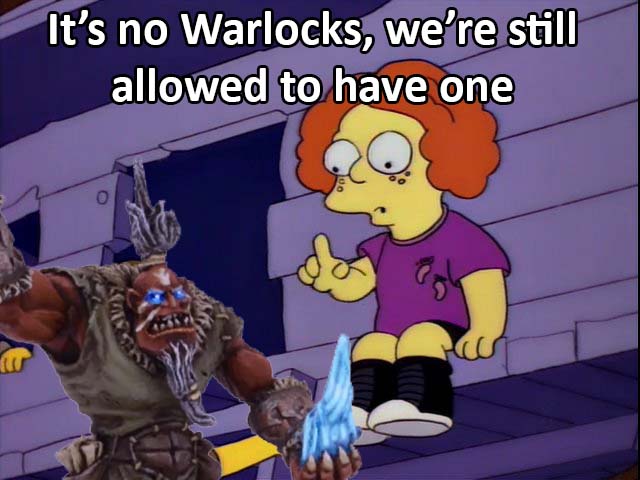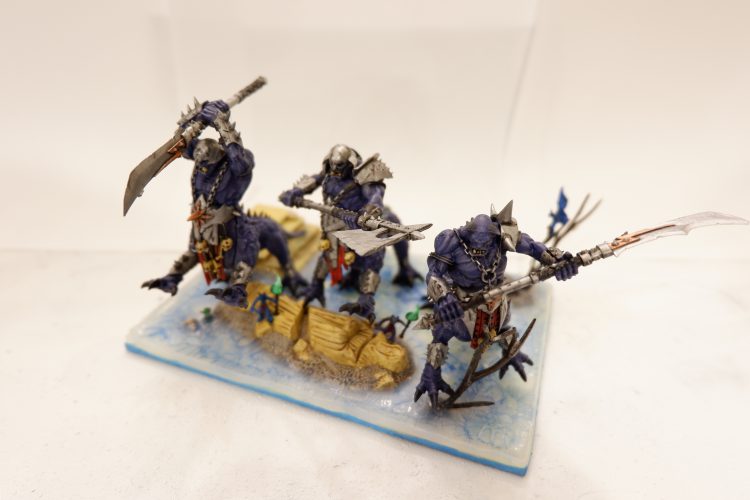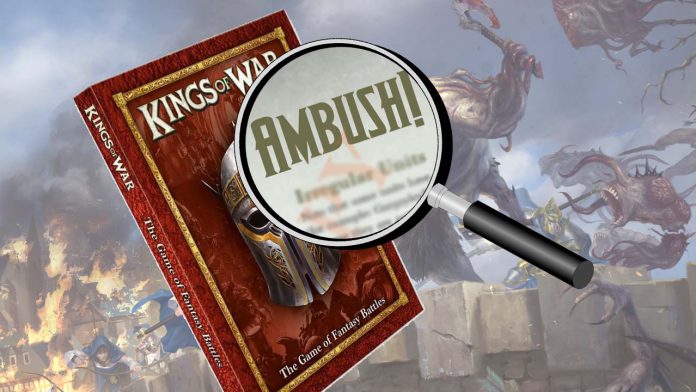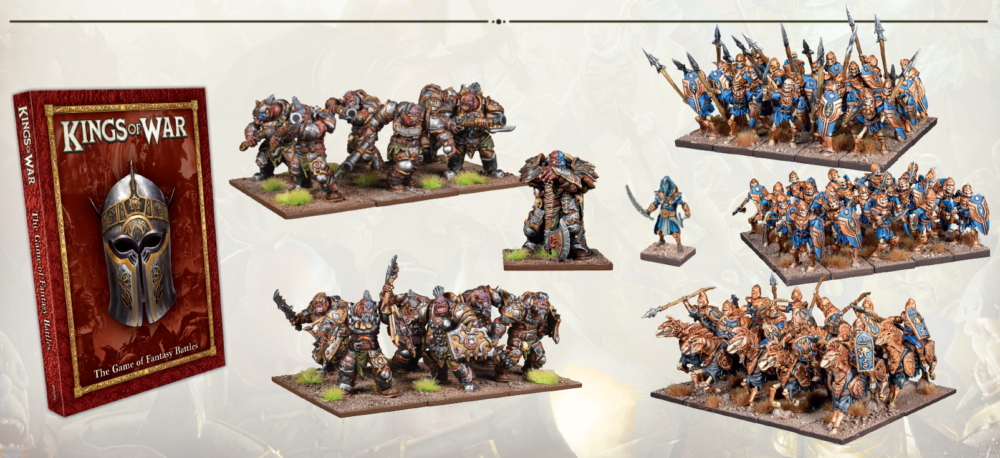G’day Goonhammer readers! The new Kings of War (2022) rulebook (aka Gamer’s Compendium aka Big Red Book), the final new game mode we have yet to cover is Ambush: smaller, quicker games of Kings of War. Thus far we have revealed the massive Legendary Games and the epic Siege Rules, but now we get to talk about something comparatively small, yet it’s a big deal for Kings of War.
Who is Ambush for?
A lot of people think smaller games are just for beginners, but where Ambush differs is that the rules for building armies differ just enough to make the whole experience more balanced and tighter. The core concept is nice and simple, and so are the modifications needed to bring Kings down to this level and keep the games’ balance intact. In fact, there’s only one and a half pages of rules needed to play Ambush.
We think Ambush is good for:
- Beginners to Kings of War: get stuck in and play straight away with the contents of a starter box.
- Trying out a new army: only need to purchase a few units to start trying out a new force.
- Introducing people to the game: a default game mode for sharing the game with friends.
- Getting more games!: one afternoon can now host three games, a tournament could have six!

Two player starter sets can jump right into Ambush, such as the new Sands of Ahmun boxed set (Credit: Mantic Games).
A good case of shrinkage
Starting off, points are obviously smaller, that’s the whole purpose. Generally, you’ll be looking at 750-1000 points a game, played on a 3′ x 3′ board, in about an hour. Not much more to say except that this board size also matches Deadzone! Easy to fit on a kitchen table or your work desk when the boss isn’t looking.
Ambush army composition
Troops and Regiments are the bread and butter of an Ambush game. Unlike full size Kings of War, Hordes and Legions cannot be taken, and neither can units of 250 points or more. No hordes of Siegebreakers who kill everything they touch, nor can you take a legion of Zombies who can never be killed. The bonus is Troops unlock, so army composition gets a lot more interesting – Abyssal Guard or Paladin Troops suddenly have some use.
Unique units, formations, upgrades, spells cannot be taken in Ambush games (ie. anything with [1] next to its name). Jarvis or the Green Lady aren’t showing up to this little skirmish, they only come for the big battles. Same goes for Allies, which just makes sense (not much points to spend on Allies even if they could be taken).
There is a cap of a total of three Heroes, Monsters, Titans and War Machines, with no duplicates of these kinds of units. Like in standard games, Irregular (*) units also need to be unlocked, but in Ambush all Flying units, even those that are usually regular, also count as irregular.

Unlocking these units is simple. Each regular Regiment and Troop unlocks one chance to take one of the above. Want a Thegn, Ice-Queen and Frost Troll Prime? Then you’ll need three regiments or troops of Northern Alliance units.
Tons of terrain for tiny battles
There are a few recommended changes to your usual terrain set-up. Due to the small armies, shooting a unit before it gets to do anything can be a much bigger deal. Likewise, a unit with Pathfinder can project a lot of threat when there’s not as much board space to mitigate bad positioning.
Given this, a higher density of terrain than usual including more Blocking Terrain and Obstacles to reduce the power of Pathfinder are the main recommendations. The denser terrain won’t affect the movement that much, as there aren’t any hordes or legions to worry about getting stuck. Of course, the smaller board also means your deployment zone is smaller, so make sure you leave space to put your army when designing the map!
Smol scenarios
Last of all, there are modifications to some of the scenarios to improve playability in these smaller games. These include:
- Loot tokens and objective markers need only be 9” apart instead of 12”, and every scenario using them uses less.
- Control involves only quarters instead of six zones.
- Dominate is only a 9” zone in the middle.
As can be seen the essence of Kings of War battles are retained at these smaller scales, with only the grand spectacle of the larger units like Hordes and Titans missing. This is perfect for getting people hooked, then they see the cool dragon or mass unit of Ogres and just want more!
Experiences playing Ambush
Urr
We had a nice little afternoon session, managing four games in an afternoon, with four experienced players and had a blast, electing to keep playing around with Ambush over sitting down for a big game instead. If you know the rules, the games can play quite quickly, and with the smaller armies, if something goes wrong, they can be over very quickly.
Free Dwarf Beserkers with Pathfinder smashed up my Nightstalkers. Less dice also means you are more susceptible to dice variance, but that is part of the fun, and if you’re with your friends, it’s fun to just rack up another game (and forget about the last one!).
We found a few interesting things, some of which Mantic have caught. Fly is extremely good, and you can see why the Irregular restriction is there. Pathfinder is also very good, so you can bet Flying Pathfinder units will be very strong (looking at you, Greater Air Elemental). I mucked about with a Shadowhulk and a Planar Apparition to heal it, but that ended up being too much of a points sink and the Hulk quickly got flanked after the rest of the list collapsed. There is a recalibration required to estimate charges on the smaller board, when everything crosses it at a greater speed, comparatively.

There also actually seems to be a place for those mixed arm units that aren’t Gladestalkers, who still remain good. Things like Free Dwarf Rangers and Northern Alliance Pack Hunters that can weaken units then charge in to finish them off (though perhaps it was Pathfinder on these units, too).
I’ve also had a shot at introducing a friend to Kings through Ambush, and we both had a blast. Its small size meant we could get a teaching game in after work and not be out late, and the size helped with decision paralysis. It is also a nice intro to unit profiles, which is something as experienced players we don’t think about very often, but it is something new players need to get used to. Remembering four or five types of unit stats is an easier place to start. The friend mentioned above has since come along to a local event, borrowed an army and placed higher than both of us, so it turns out I can teach ok.
Cytoplasm
The afternoon session of Ambush was at my place, and we managed to get three games done in an afternoon, making the whole act of organising such an event very much worth it. We could all try out new army builds, and changing lists on the fly was very easy when it’s just a few units to chop and change.
My primary issue with Ambush is how my armies have been built. In my Forces of the Abyss and Goblins, all my units have been based for regular Kings of War; hordes of Trolls, Molochs, Goblins, Ghouls and Lower Abyssals. Not being able to use these severely limited my ability to construct different kinds of armies, because the only Abyssal units that can fit are my Abyssal Guard and Horsemen. In my future armies, such as my Trident Realms, I will make sure to have split multibases so that I can run smaller unit sizes, and I recommend others do this, too, if they want flexibility. But that’s the only issue I had.

The games are so fast, but still have the essence of what makes Kings of War truly exciting. Positioning still matters, unit matchups are important, and as usual the dice ultimately decide all.
The primary difference with these smaller games is that each unit lost has a greater impact; a regiment is a major portion of a 1000 point army. It is for this reason that shooting is quite powerful, but not in the same way as larger games. I tried taking a heavy shooting army with my Abyssals, but it struggled to survive in the later turns; my Flamebearers just got beat up! Instead, the units that could shoot and fight excelled. Dwarf Rangers and Gladestalkers, even in Troops, were incredibly useful all game. They could shoot off weak units, but also get onto objectives and hold them, something Flamebearers cannot be relied on to do.
Ultimately, I look forward to playing some Ambush games with people new to the game; my wife, my brother, and friends from other wargames. It’s perfect to get the feel of Kings of War across without overwhelming amounts of decisions and stats to follow. This will definitely help getting new folks into Kings of War!
The Big Red Book Cometh
Thank you to Kyle from Mantic for giving us an early review copy of the new rulebook. We hope our readers have enjoyed the reveals, and we encourage everyone to get the book if anything for just the convenience of having it all in one place.
We could go into all the changes applied to various units in another article, but by this point everyone will have the book and it’s actually quite a job to go through all the unit entries and find the subtle differences they have compared to before. In most cases there were some points tweaks, minor stat changes or a revision of an ability wording. There are some cool revisions to units, changing up entirely how they work, but we will let our readers find these for themselves.
Until next time, enjoy the book, and we look forward to bringing more Kings of War content!
Have any questions or feedback? Drop us a note in the comments below or email us at contact@goonhammer.com.



